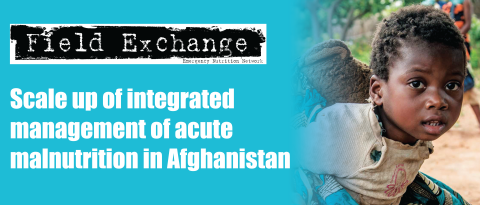Resilient farming in Satkhira, Bangladesh
By Emmanuelle Maisonnave and Julie Mayans
Emmanuelle Maisonnave is the Institutional Knowledge Building Officer at Solidarités International, where she facilitates lesson learning within the organisation.
Julie Mayans is Food Security and Livelihood Advisor at Solidarités International. She has been working in this field for over ten years. Her job involves providing technical support and capacity-building to field teams and producing technical guidelines. The authors would like to acknowledge Solidarités International’s team in Bangladesh for its support in reviewing the case study on which this article is based.
Location: Bangladesh
What we know: Bangladesh is the sixth-worst extreme weather-affected country in the world, which negatively impacts agriculture, the main economic activity.
What this article adds: In 2016 Solidarités International (SI) supported vulnerable farmers in Satkhira district to improve farming and livelihood resilience and disaster-risk reduction activities, in close collaboration with the Ministry of Agriculture (MoA). This involved supporting access to improved and resistant seeds; improving agricultural practices (better adapted to the micro-climate and soils); and developing integrated farming (dual-crop system). SI teams elaborated business plans with beneficiary farmers and distributed cash grants for sustainable farming enterprises. A qualitative project review found diversification of agriculture activity (reduced monoculture), more resilient crop production, greater income generation (cash crops), greater yield per land area, increased awareness and practice of sustainable farming activities and more diverse food access by households. Working with MoA agriculture extension workers is key to sustainable success. Transformation of agricultural products (e.g. mat making) provides important income-generating opportunities. Resilient seed banks may have a role in emergencies. Active communication with farmers is key to keeping them updated on current farming techniques.
Context
According to the Global Climate Risk Index 2017, Bangladesh is the sixth-worst extreme weather-affected country. The frequency and intensity of climatic events such as floods, droughts and cyclones have escalated, aggravated by climate variability and change. Bangladesh is located in the largest river delta in the world and is heavily reliant on the natural tide system for its prominent agricultural sector, particularly in the southwest coastal region. With the impact of climatic changes and human activity, the country is experiencing dramatic environmental decline, making the region extremely vulnerable to hazards and natural disasters.
Satkhira is a district in southwest Bangladesh located on the bank of the Arpangachhia River. In the 1960s the government constructed a network of polders, embankments and drainage channels in the coastal regions as defence against water intrusion and to increase agricultural production. Poor maintenance of sluice gates, design flaws and the gradual sedimentation of the canals have contributed to serious waterlogging in the Satkhira region. During the monsoon excessive rainfalls inundate the land and inadequate drainage prolongs flooding. Great areas of land remain waterlogged for several weeks and sometimes even months (20 per cent of the land was severely affected by waterlogging in 2015). This is aggravated by cyclones and subsequent storm surges and severe droughts. High water salinity also adds to the problem, caused by saltwater shrimp farming that requires large bodies of salt water; saltwater shrimping has occurred increasingly further inland since the 1980s, sometimes using canals constructed by the government, thereby blocking drainage and causing more waterlogging. All these issues greatly affect the quality of the soil and threaten crop production.
Agriculture is the main economic activity in Bangladesh, providing employment to over 45 per cent of the population (Bangladesh Bureau of Statistics, 2015). Satkhira district is characterised by smallholder subsistence agriculture, based on a saline wet rice ecosystem. Farmers generally only cultivate Aman rice, a type of monsoon-dependent rice sown in June/July and harvested in December/January. The rest of the year, farmers either leave their land fallow due to salinity problems or they cultivate fish and/or vegetables. Households own on average between 33 and 50 decimals of land (less than 0.2 hectares). This is insufficient for many farmers, who lease other fields to extend their cultivation capabilities. Due to the pressures described, small farmers living in the coastal belt struggle to generate a decent standard of living from their agricultural activities and are compelled to adapt their practices.
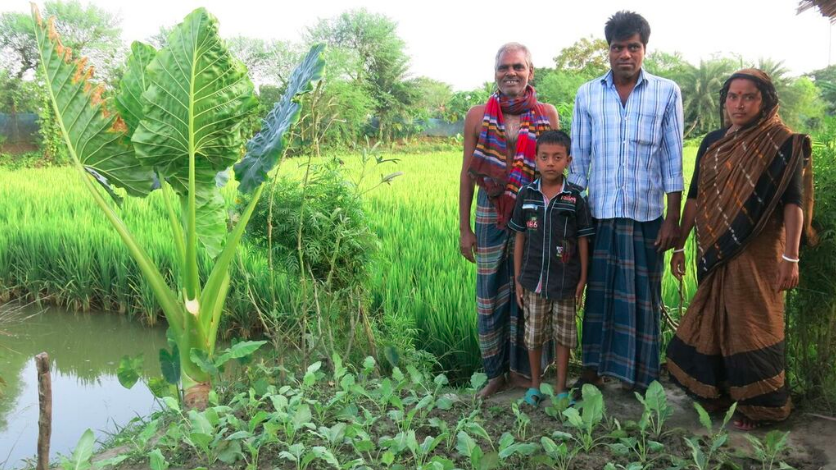 Intervention for resilient agricultural livelihoods
Intervention for resilient agricultural livelihoods
Solidarités International (SI) implemented disaster-risk reduction (DRR) activities in Satkhira district between 2010 and 2016. It supported communities to identify the impacts of the main hazards and local capacities to face them, and to collaborate on ways they could reduce these vulnerabilities. Based on risk-reduction action plans (RRAPs) developed with communities at the upazila (sub-district) and ward levels, it was determined that specific support should be given to farmers to launch resilient farming and livelihoods activities, with the aim of mitigating the impact of hazards and disasters and reducing their vulnerability. The aim of two projects implemented in Assasuni upazila1, Satkhira district (the first in 2015; the second in 2016) was to help the most vulnerable households cover their basic needs, while simultaneously laying the foundations for sustainable and long-term livelihood recovery, thereby bridging short-term and long-term humanitarian assistance. SI worked to enhance existing agriculture-based livelihoods by promoting adaptation strategies and mitigation and preparedness techniques to reduce core vulnerabilities. The intention was to encourage a proactive rather than reactive approach to enable communities to build on their own capacities to cope with disasters, should they strike.
Three components of the programme contributed to improved resilient farming: supporting access to improved and resistant seeds; improving agricultural practices; and developing integrated farming, each described in more detail below. These activities were implemented in close collaboration with two Agricultural Extension Officers (AEOs) commissioned by the Ministry of Agriculture (MoA) to work with agricultural research institutions and disseminate new technologies, inputs and techniques at field level. The project was implemented in Assasuni and Tala upazilas: Borodal, Dhandia, Khajra and Nagarghata unions. A total of 390 farmers were supported to develop integrated farming and 1,000 households received a grant to buy seeds and equipment. SI’s team was made up of a team leader and ten community mobilisers.
Supporting access to improved and resistant seeds
To secure food supply in Bangladesh, the development and use of high quality seeds that can adapt to certain unfavourable conditions (such as waterlogging and salinity) is essential. Research institutes, such as the Bangladesh Rice Research Institute and Bangladesh Institute of Nuclear Agriculture, are continuously creating new varieties of stress-tolerant seeds. However, small, isolated farmers are rarely aware of the characteristics of the new varieties and which ones are usable on their land and lack access to markets. SI encouraged the use of improved seeds and facilitated access to them2 by providing cash to vulnerable farmers.
Box 1: List of criteria to identify vulnerable farmers
- Village vulnerable to disasters
- Household severely affected by waterlogging in the past few years
- High level of loss of livelihood and slow or no recovery and/or coping strategies
- Low level and irregular source of income (less than 5,000 BDT per month)
- Ownership of less than 0.5 acres of land
- No access to adequate food sources
- Socially vulnerable households (women and elderly headed households; households with young children, disabled persons, pregnant women or sick persons).
Together with AEOs and SI community mobilisers, beneficiaries identified the stress-tolerant crops that could easily and efficiently be grown on their land.
Introducing sustainable agricultural practices
Resilient farming entails using agricultural practices that are better adapted and more sustainable to the pedo-climatic context (the specific microclimate soils). Overall, farmers in Assasuni upazila were ignorant of new techniques and practices that would enable them to cope better with worsening hazards such as salinity and waterlogging. The project aimed to improve farm management by using methods and techniques transferred to farmers by AEOs to suit their specific environment. Examples include the use of good quality seeds to improve germination rates and yields; better soil preparation and sowing (line sowing; bed and furrow system to enhance irrigation efficiency and reduce salinity; dosage of manure to fertilise the soil before sowing; integrated farming; land preparation); timely irrigation and drainage (such as alternate wetting and drying technology to allow the leaching of the salts and mulching); use of natural fertilisers and pest management, and land management techniques in saline conditions.
Developing integrated farming
Single crop farming is a risky enterprise, especially in a context of high hazard vulnerability and low resilience capacity. Crops were also needed that could provide a continuous and balanced supply of food and income. Integrated farming, which is the combination of two or more farming and livestock enterprises in a complementary or supplementary way on a single plot of land, enables the optimisation of resources and land and consequently a maximum production per unit area. This technique is particularly adapted to the coastal belt of Bangladesh; specifically, a dual-crop system was found to be most suited to Assasuni upazila. This involves integrated fresh water aquaculture (fresh water white fish and prawns, which do not have the same negative environmental impact as the salt water shrimp previously farmed), alongside stress-resilient agriculture (paddy and vegetables, such as various types of gourd, pumpkin, beet, spinach, cucumber and potato), with different enterprises according to the cropping season. In rice-fish-vegetable farming, the paddy field is left open to encourage the fish to enter and swim around the paddy. When water levels drop, the fish stay in the ditches surrounding the rice field. The pond is used to water the vegetables growing on the surrounding dykes (described in Table 1).
Table 1: Types of enterprise in an integrated farming system according to the three main cropping seasons in the coastal belt
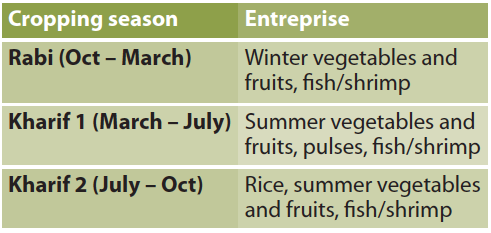
Implementation
SI teams elaborated business plans with beneficiary farmers and distributed grants for sustainable farming enterprises. A typical plan for the distribution and use of a grant is described in Table 2.
Table 2: Example of a grant provided by SI for a beneficiary farmer in 2016
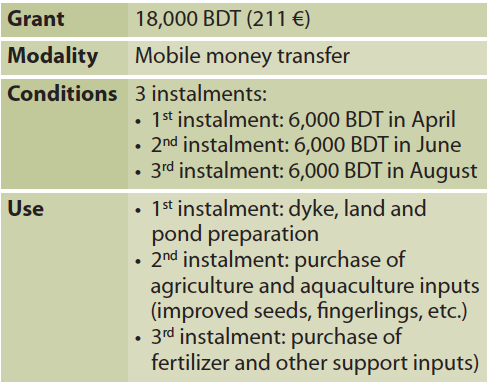
Demonstration plots were created to serve as venues to teach technologies and to demonstrate differences between traditional and ‘modern’ techniques. These aroused local interest and contributed to the acceptance and uptake of these new techniques and seeds. Beneficiaries with plots on their land were tasked with sharing information with non-beneficiaries to encourage dissemination further. No support was given to access markets as it was felt that sufficient demand for the produce already existed.
Impact of the intervention
Direct observations and individual interviews, as well as analysis of logbooks kept by beneficiaries on the yields of their crops, revealed that the intervention contributed to securing the livelihoods of vulnerable farmers and their families in the target area. More specifically, the activities enabled the following results:
The spread of risks through the diversification of resilient sources of income
A key feature of livelihood resilience is to spread the risks of shocks and seasonality across several sources of income. In preparing this project review, the authors were unable to assess concrete impacts of risk-spreading, as no major climatic event or disaster occurred. However, the efficiency of diversification as a risk-reduction strategy is evident and has been demonstrated in numerous studies (Gil et al, 2017). If one source of income fails, the others can compensate, enabling the household to cope. The project worked to reach this objective in different ways.
First, diversification limited monoculture paddy. Farmers were immediately encouraged to multiply the number of crops cultivated on their land. Vegetables grown included tomato, eggplant, pumpkin, various types of gourd, okra, long yard bean, water spinach, Indian spinach and amaranth. Secondly, better knowledge and access to improved seeds ensured more resilient sources of income. The T-Aman paddy varieties promoted during the trainings are more resistant to waterlogging and salinity and are higher-yielding. The average yield of hybrid seeds such as BR-10 and BRRI dhan 49 is 5.5 tons per hectare, compared to 2.07 tons for traditional Jamaibabu rice. Similarly, cultivating salt-resistant vegetables throughout the year enabled better yields and consequently bigger regular surpluses to sell on the markets. Thirdly, the spread of risks was further intensified by some farmers through the cultivation of resilient cash crops with a potential added value. Examples of cash crops cultivated were mele (a type of reed that originates from the Sunbardan mangrove forest located along the Bay of Bengal which grows well in brackish water (water that has more salinity than fresh water but less than sea water) and can survive in medium salinity level (EC 4 to 8 ds/m) saline land and water) and/or jute, both highly profitable plants. In the case of mele, farmers were supported to process it and transform it into mats to generate added value and more revenue. Mat weaving can be done throughout the year, especially during the rainy season, when other farming activities slow down. See Table 3 (seasonal calendar).
Table 3: Seasonal calendar for Satkhira
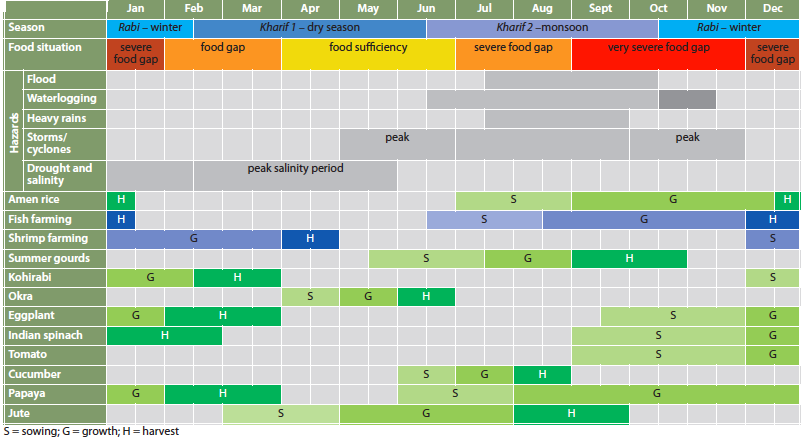
Interviews with farmers showed that these three components generated greater and more regular incomes from several sources (see Box 1 for a selection of case studies). The average income per beneficiary implementing integrated farming was 122,068 BDT, compared to 61,363 BDT the previous year at the same period. Three quarters (74 per cent) of beneficiaries said they had improved their income compared to the previous year. Expanding the portfolio of farming and non-farming activities increases farmers’ ability to buffer a shock affecting one activity. Coupled with the use of more resistant varieties of rice and vegetables, the diversity of crops and products ensures that revenues are more sustainable and resilient.
Box 2: Case studies of diversification of sources of income
Nirod and his wife Sobita-Rani expanded their mele production with part of the grant they received. In 2015 they grew some mele on their 0.33 acres of owned land. In 2016 they rented 0.66 acres of land to augment the production, making almost 60,000 BDT (over 600 €) from two harvests of mele. Almost half this income is from selling raw mele; the other half is from mat weaving.
Chanchala and her husband cultivated 480 kg of BR-11 Aman rice on 1.2 acres of land in 2015. In 2016 they started integrated farming and changed to BR-10 and BRRI dhan49; they yielded 780 kg on the same surface area.
Before 2015 Parimal produced rice and some fish separately for a total of 69,300 BDT (almost 700 €). With the help of the project, he started producing vegetables on the dykes surrounding his pond and paddy field; he obtained 4,590kg of cucumbers, eggplants, papaya, beans, tomatoes, bananas, okra, Indian spinach and bitter gourd. He sold 3,860kg at different periods of the year for a total of 80,950 BDT (800 €).
Increased awareness of the importance of sustainable farming practices
Natural resources in the coastal belt are fragile and must therefore be exploited in a sustainable and reasoned way to ensure that farmers can maintain their rural-based livelihoods now and in the future. The resilient farming interventions were designed with sustainability in mind and the trainings promoted environmentally friendly principles. Integrated farming is a viable, low-cost, low-risk and sustainable activity that enhances natural biological processes and lessens the degradation of soil quality, with maximum output for minimum input. It is better than rice monoculture in terms of resource utilisation, diversity and productivity. The optimisation of the land also contributes to reducing salinity levels; when the land is left fallow, the soil moisture evaporates and this consequently increases the concentration of salts.
Moreover, natural fertiliser and pesticide techniques were promoted during the trainings, including the use of organic compost or cow dung, bird perching, sex pheromone traps, nets to capture bugs, light traps, neem leaves and manual control of insects. Farmers also learned how to mitigate the consequences of hazards by preparing and managing their fields more carefully. Example feedback from participants is included in Box 3.
Box 3: Feedback from participants
“We had no idea about salinity management before. Now we know how to grow in saline conditions. For example, we cultivate very frequently so the salt doesn’t come out. If we let the land to rest, it will be more saline.”
“The training we received helped us to improve the management of our land so we can have better yields without damaging it. Now we transplant the rice in rows. We are able to manage weeds and we use organic pesticides. We have increased our visits to the fields and we monitor the crops more frequently, so we have better control of our fields. We also use cow dung as a fertiliser for rice. This has doubled our production – before we made four to five sacks of rice per year, now we make 11 to 12 sacks.”
The reduction of food insecurity and improvement of diets
The diversification of crops and increase in production have had nutritional benefits and have provided an important solution to food insecurity in Satkhira district. Regular increased crop production enables continuous access to food and crop diversification provides a broader range of food items, such as grains, vegetables and fish, which leads to a more diverse diet. Interviews with beneficiary farmers confirm this (see Box 4). Moreover, because they could consume larger quantities of products from their farm, households reduced the share of food expenditures in their budget. No data on dietary diversity, food security or household expenditure were available for this period to provide evidence for this.
Box 4: Feedback from participants
“Before, we could only take two meals a day and we were sometimes hungry. But since we started growing vegetables, we can eat three meals a day and we don’t have to spend so much money of food.”
“Integrated farming provides vegetables, rice and fish and in enough quantities for us to eat well and to sell surpluses.”
Lessons learned
The process of writing this article enabled the authors to reflect on this programme and take stock of the intervention in Satkhira district regarding resilient farming practices to improve livelihoods. Several lessons were learned and recommendations made to improve future interventions:
Working in close collaboration with the AEO in charge of implementing the MoA’s directives was important to the success of the programme, especially regarding technical capacity-building and the long-term communication between agricultural state authorities and farmers. This relationship can also facilitate the development of markets for transformed products and of new marketing channels.
Access to inputs must be carefully planned to ensure sustainability; farmers must be trained on seed storage and on ‘home-made’, simple preventive and curative pest and disease treatments. Resilient seed banks can also play a key role in case of an emergency (if crops are destroyed by a flood, for instance) and must be implemented closely with the local authorities and the MoA.
Demonstration plots were a very efficient and effective method to promote good practices.
The transformation of agricultural products should be considered to further spread the risks of crop failure and to generate more income by adding value to the raw product.
Sharing information and communication with farmers is of prime importance in such a context, where farmers need to continually renew their techniques to adapt to changing and aggravating hazards and disasters.
SI hopes to conduct a follow-up impact assessment in 2018/19; however, lack of funding has meant continuation of this programme by SI was not possible. More broadly, funds for resilience and livelihoods programming have diminished, fuelled by the response to the current Rohingya crisis, which has been prioritised and is dominating agency response.
Conclusions
The agricultural activities described here directly addressed the livelihood vulnerabilities of Satkhira’s disaster-affected communities. Marginal farmers were assisted in the adoption of resilient farming techniques and acquired reflexes and practices to reduce risks associated with seasonality and to be more autonomous and resilient. The improved seeds that were promulgated can be used for several seasons and the income created should enable farmers to renew their seed stock, buy or rent equipment and take on labourers for land preparation.
This type of intervention is very valuable in a context of high-salinity and waterlogging. However, it must be noted that the consequences of climate change and the occurrences of hazards and disasters are very likely to worsen in the coming decades. If the frequency and intensity of these disasters increase beyond what resilient practices and varieties can bring as a solution, other non-farming livelihood options must be considered. According to researchers from Khulna University (Zahangir and Salauddin, 2015), stress-tolerant varieties have limitations: they might adapt to more adverse conditions, but the yields will be reduced and incomes will consequently decrease. How long will resilient farming therefore be a sustainable solution to securing the livelihoods of the vulnerable farmers of coastal Bangladesh?
For more information contact Emmanuelle Maisonnave and Julie Mayans.
A detailed case study of the experience described in this article is available here.
Endnotes
1Specifically, these two projects were implemented in: Dhandia and Nagarghata unions in Tala upazila in 2015 and Borodal and Khajra unions in Assasuni upazila in 2016.
2SI prohibits the use of genetically modified organisms; the seeds were checked and validated before being distributed.
References
Bangladesh Bureau of Statistics, Ministry of Planning, 2015.
Gil JDB et al. (2017) The resilience of integrated agricultural systems to climate change. Wiley Inderdisciplinary Reviews: Climate Change, vol. 8, no. 4, doi:10/1002/wcc.461.
Zahangir H and Salauddin S. Impact of adaptive agriculture and aquaculture in waterlogged and saline areas of Bangladesh: a case study on Satkhira district. Khulna: Khulna University, 2015.


